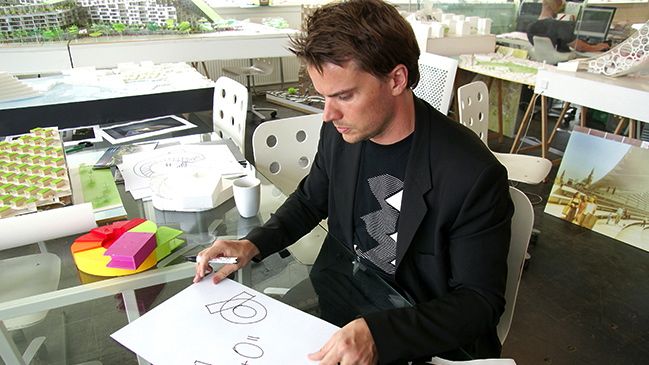
July 8, 2013
Ingels, Parvin, Murphy: Architecture’s New, Essential Wave
Why Bjarke Ingels and the next wave are essential to rethinking architecture

Courtesy BIG
Bjarke Ingels inspires the early-morning crowd squeezed into the massive Sauganash Ballroom at Chicago’s Holiday Inn Mart Plaza. We’re here for the keynote that kicks off NeoCon. The youthful Dane is the perfect choice to open the annual trade show for contract furnishings in this pivotal year. With considerable wit, irreverence, and optimism, he talks about ideas that also will energize the crowds flocking to the showrooms at the Merchandise Mart on those three days in June. He shows us the results of his thriving firm: BIG’s investments in time and resources for research and technical expertise are mixed with a humanist outlook, which he defines as the architect’s “capacity to capture the soul of the subject.” He reminds us that the most important contributions architects can make to society and the environment are the “power of our ideas” and “practical visions.”
Listening to Ingels, I recall a recent visit to a mature architecture firm—and the word “malaise” pops into my head. The talk there was about what can’t be done, how clients “don’t get it,” and how the post-recession economy devalues design. Any suggestion of the necessity for research to expand the firm’s knowledge base meets with reasons why this is impossible to fit into a practice pushed to the limit by fast-track projects. Any thought of fully engaging the new generation with their special tech skills and idealistic drives is considered naïve.
Yet this new generation is hard at work, shaping the profession’s future. I think of Alastair Parvin, an energetic Brit who graduated from architecture school just as the bottom fell out of the market. For him and his colleagues, facing unemployment was an opportunity to rethink their life mission. “As a society, we’ve never needed design thinking more,” he pleads. He’s outraged that architects still serve the privileged one percent of society, when the other 99 percent needs them desperately. Alastair is a member of the team responsible for designing the WikiHouse, an easy-to-assemble structure that can be built anywhere by willing community members. Its design is openly shared, ready to be downloaded, and printed with a CNC cutting machine. “This,” he asserts with confidence, “is a revolutionary way of producing architecture.”
Among the young American firms that have chosen a similar path is the MASS Design Group. Its research-based, community-oriented design philosophy gets the architects involved in everything from job training to employing their observational and analytical skills to find common-sense architectural solutions to serious problems. For instance, MASS’s now-famous hospital in Rwanda has open-air corridors designed to disperse tuberculosis germs, ultimately limiting contagion.
Though these new entrepreneurs follow the tradition of famous architecture firms with a charismatic personality as their public faces—BIG’s Bjarke Ingels, WikiHouse’s Alastair Parvin, and MASS Design Group’s Michael Murphy—make no mistake about it: they are not purely ego and flash. These architects are rescuing their profession from its debilitating malaise. Watch them thrive and inspire a generation looking for meaningful work. What, I ask mature firms, can you learn from them?





